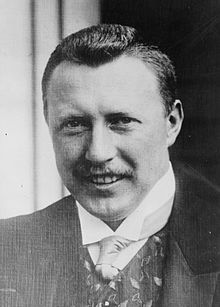Wilhelm Filchner | |
|---|---|
 Wilhelm Filchner in the early 1910's | |
| Born | 13 September 1877 |
| Died | 7 May 1957 (aged 79) |
| Nationality | German |
| Citizenship | Germany |
| Education | Prussian Military Academy, Technical University of Munich |
| Occupation(s) | Army officer, scientist, explorer |
| Parent(s) | Eduard and Rosine Filchner |
Wilhelm Filchner (13 September 1877 – 7 May 1957) was a German army officer, scientist and explorer. He conducted several surveys and scientific investigations in China, Tibet and surrounding regions, and led the Second German Antarctic Expedition, 1911–13.
As a young military officer, Filchner gained an early reputation for dash and daring, following his travel exploits in Russia and the Pamir Mountains range. After further technical studies, he developed expertise in geography and geophysics, before leading a major scientific survey in Tibet and western China in 1903–05. In 1909 he was appointed to organise and lead the forthcoming German expedition to the Antarctic, with both scientific and geographical objectives involving extensive exploration of the continent's interior. During the expedition his ship became trapped in the Weddell Sea ice, drifting for eight months and preventing Filchner from establishing a land base, thus failing in its main objective. Although important scientific results were obtained, the expedition was disrupted by serious interpersonal disagreements and lasting animosities, which harmed Filchner's reputation as a leader and ended his polar career.
After service in the First World War he resumed his travels in Asia. He conducted two lengthy single-handed magnetic surveys in China and Tibet, often in difficult and sometimes dangerous conditions, and was continuing this work when the Second World War began, leaving him stranded in India. After years of internment, he returned to Europe and retired to Zürich, where he died in 1957. During his lifetime he received numerous honours, including the German National Prize for Art and Science in 1937, and several honorary doctorates. He is also commemorated in the Antarctic, where a number of geographical features bear his name.